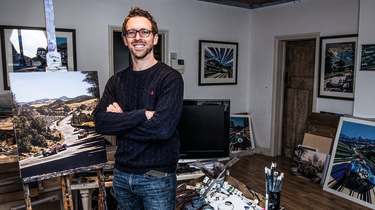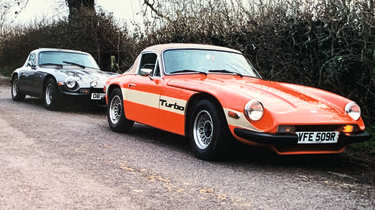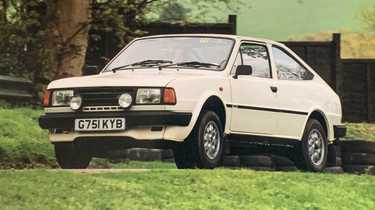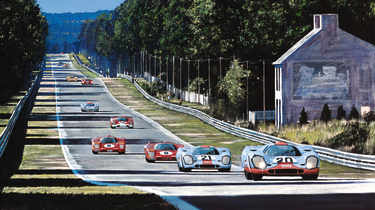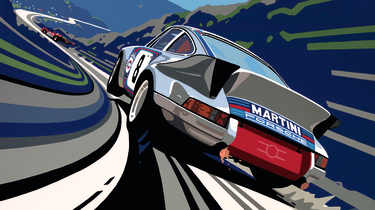My Life & Cars – Tim Layzell, motorsport artist and amateur racer
Layzell learned to drive in karts and a Skoda Rapid – experiences that stood him in good stead for his career as a motorsport artist
Tim Layzell recreates significant moments in motorsport through his art, which comes in two very different styles: realism and his version of pop art. He’s probably more famous for the latter, which zooms in on the action like a drone-mounted camera, the cars and scenery painted with limited colours, the scene given a terrific sense of speed by his trademark bars of colour streaking or swirling to distant points.
They’re compelling works, dynamic and authentic thanks to the perfect attitude of the cars. One of his newest pieces, ‘The Ultimate Lap’, revisits the 1973 Targa Florio to celebrate the 50th anniversary of Porsche’s win. You’re right there, drawn along in the wake of the Mueller/Van Lennep 911 Carrera RSR as it lifts its inside front wheel mid-corner in pursuit of one of the faster but more fragile Ferrari 312PBs.
> My Life & Cars – Frank Stephenson, car designer
Ask Layzell which Ferrari it is and without missing a beat he says ‘Arturo Merzario’s’. That’s the thing about Layzell’s work, the moment they portray probably wasn’t captured on camera – in the case of his pop art pictures, couldn’t have been – but he puts in the hours of research to know all the details: where the sun was, what lap the cars would have been on, what damage they would have had, the race order and so on. What really makes them work, though, is how Layzell gets the attitude of the cars so right, even though he’s painting them from an angle he’s imagined. That’s not chance. That speaks of a real understanding of car dynamics, an appreciation of how cars behave on the limit, so it’s no surprise to learn that Layzell was immersed in motorsport from an early age.
‘My dad has always been really interested in cars, loved them, but didn’t have loads of money,’ says Layzell. ‘He had a succession of TVRs. He’s still got a Taimar SE, wide-body, non-turbo, which he’s had for about 30 years. We used to go to Vintage Sports Car Club meetings, and that started it. I was really into the ERAs and Bugattis, Jaguar D-types and things like that. I’ve always been massively inspired by really slidey stuff, drifty people; I used to love watching Peter Hardman at Goodwood.’
Layzell’s work was first exhibited at the Coys Festival when he was just 13. He’d been drawing from an early age and got oil paints for his 12th birthday. ‘I’d entered a competition in Classic and Sports Car magazine and won the class for artists up to the age of 23.’ This saw his painting exhibited at Silverstone alongside the work of his early heroes, Michael Turner and Dexter Brown. ‘It was a prestigious thing. I went back to Silverstone the next year with four paintings and sold them all, one to a German collector with a RUF CTR. As a thank you he gave me the Faszination video. I watched it all the time with my brother.’
Still, Layzell wasn’t thinking of art as a career. ‘I wanted to be a car designer but I was rubbish at school, rubbish at concentrating. I only worked out what I was supposed to be doing there a long time after I left.’ After A-levels he got a job at Gap, the only ‘proper’ job he ever had. ‘I’m really good at folding clothes,’ he laughs. He lasted two months. Meanwhile, he was painting at home and selling most of what he produced, enough to earn a living.
His unique, pop art style developed later. Where did it come from? ‘An early influence was the late Barry Rowe, an artist who often paints motoring scenes with lots of saturated colour. He sort of tinted my art yellow for a period.’ Then in 2004 Layzell met classic car dealer and art collector Gregor Fisken. ‘He asked me if I’d done anything different. I’d done some futurist pieces for my A-level art, including a picture of two Ferraris on the 1957 Mille Miglia. I showed Gregor and he said, “Why don’t you come up with something new?” So I did. I was quite into Lichtenstein; some of my wife’s friends did their own Lichtenstein paintings in their student house. I was also into George Hamm who did the Monaco GP posters, and railway art. The confluence of all those things led to the picture for Gregor Fisken, which turned out alright.
‘After that I did what I would call my first proper pop art picture, of a Ferrari SWB. It ended up on the cover of an Art and Collectables supplement for Octane and was also used by the Telegraph motoring section as the main picture of their coverage of the 2004 Revival. It got busy after that. Then in late 2017 I had the cover on Christophorus (the Porsche AG customer magazine) and it went really mental after that. I already had a big waiting list and it went out to two years.’
He paints both realism and pop art styles these days. ‘I start with a dark canvas and add the brightness – I rarely do a picture without lots of shadows or darkness. Depth is about building contrast, and I feel that I’ve nailed that formula now.’ In both styles, the authenticity comes from years of watching classics racing and a fanatical approach to research, but to truly understand, you need to have been there. ‘I used to do a bit of karting when I was younger, from 8 to 13, and when I was learning to drive my brother had a rear-engined Skoda Rapid. My friends all had Golfs. On the drive home from the pub I’d be drifting the Skoda through the lanes like a cut-price 911!
‘My first car was a Volkswagen Polo Coupe. My brother was at Bristol University and we did loads of 12 Car Rallies; they were great, I really miss those. Then I had an Audi 80, just a 1.8 but, again, we put spotlights all over the front and did lots of rallies. It was a brilliant car, so solid, and the handling was really neutral. Our cross-country drive to Silverstone was on epic roads, you’d be disappointed when you dipped below 100. Then I had a Skoda Fabia vRS. At one point I bought a Fabia 1.2 SDI, the slowest car I could find, because I had six points on my licence. Then I had a Midas Gold kit car, which was quite cool, and then I got into my TVRs.
‘I had a 1976 TVR 3000M Turbo when I was 20, which was a pretty cool car: blood orange, cream vinyl roof, so it would be very on-trend now. I also had four Chimaeras, because every time I sold one I realised it was a massive error. I lived in Clifton, Bristol, used them almost every day. They’re quite practical, massive boot. For all the mickey-taking I think I broke down once in all the time I had them, and that was an alternator, which could go on any car. I still wish I had one now.
‘I chopped in a Chimaera for a T350 and saw a step change in dynamics. I did quite a few trackdays in it, quite a few Mission Motorsport days. I’d donate pieces to Mission Motorsport now and again and James Cameron [founder and CEO] asked if I’d bring cars to the trackdays and take people out. It’s massively rewarding. As James always says in his speech at the start, most of it is about the conversation in the car. Quite a few of these people have got PTSD. It can be quite transformational.
‘Sometimes they’ve just got a GT3 or something with paddleshifts, you know, massive tech. In the TVR, I tell them we haven’t got any ABS or traction control, there’s no door handle, the fire extinguisher is between your legs... Half a lap in they look a bit terrified. Total sensory overload, even though we couldn’t run the exhaust that makes it sound like a Lister Jaguar. You can drift it quite a lot but in no way is it relaxing on the limit. You’ve got to find the gears manually going into Madgwick: miss one gear and you’re going off.
‘There was a guy who’d been in my Grantura. I saw him two years later and he said it kind of changed his life. He’d not really left the house for a long time. He was a royal engineer, kicking doors in, a superhero kind of action man but then couldn’t walk down the street without his back to the wall. He went in my car, then another and it sort of got him on the change. I think he went on to work abroad. So, yeah, it can be very transformational.’
Layzell has now raced. ‘Obviously, I wanted it to be a D-type or a 250 SWB…’ It was, appropriately, a TVR, the Grantura Mk3 Lightweight, which turned out to be more famous than he thought, having competed in many races at Goodwood. ‘I got invited to a Members Meeting… but I didn’t have a full race licence. Then I got invited a second time so I borrowed James Cameron’s E30, did a few races, did a marshalling day and an advanced ARDS to get my eight stamps and then, literally, I was on the grid at Goodwood. It was ridiculous. I thought “What am I doing here?” I’d done a couple of trackdays in it and a couple of test sessions, and I think I qualified fifth and finished fifth. Had a massive ding-dong battle with an MGB driven by Harvey Stanley of DK Engineering and the 911 of Mark Sumpter of Paragon Porsche. It was a mega race.’
Enthused, he looked for a car to do a different category in and found a 1965 BMW 1800 Ti/SA (Sonder Ausführung – Special Version). It wasn’t his first BMW. ‘I had an old E34 5-series when I was 19, a bright red 518 so that I looked like a banker, but a failed banker. The Ti is a brilliant drive. Eddie Cheever had driven it at Goodwood. I de-stickered it, made it kind of retro-looking, more authentic Nürburgring mid-60s. It’s so neutral, very drifty. It’s got 206bhp, so it’s quite powerful but you’re obligated to run it at 1000kg, while the Lotus Cortinas are 720kg. And you can’t out-drag the Minis, so you have to catch all these cars up in the corners.
‘I bought it just before Covid. We did Speedweek in 2020, no crowds, which was just bizarre. We did a day testing and were down in the low 33s, bizarrely only 0.1sec away from the TVR. I shared it with Marino Franchitti for the weekend. Running about 10th in my race, I went to go around the outside of a Cortina at the second part of St Mary’s; he didn’t really leave enough space and I got a wheel on the grass and span it, 360’d it, which contributed to breaking an engine oil seal. I got oil on the tyres and it was quite a hard battle after that. Some crazy angles. We did finish the race though.
‘I raced the TVR at the same meeting in the Stirling Moss Memorial trophy, sharing with Dickie Meaden. We qualified 11th, which was pretty amazing – we were the only car to get the bonnet lifted in scrutineering! We beat the Healeys, E-type Jags and a Ferrari 250 SWB and it was a fantastic race. Stirling had just died – I’d painted him a huge amount over the years so it was pretty amazing to be in that race.
‘It’s bizarre that, for someone immersed in motorsport, I haven’t driven that many tracks. And although I paint it every day and I live it all the time, I’ve never been to a Grand Prix. How terrible is that?’ It doesn’t show; now 41, Layzell’s art is in great demand. He still goes to selected shows, including the Revival, but commissions account for most of his annual output of 15 to 20 pieces. He has been commissioned to create the posters for the Pebble Beach Concours for over a decade, these sort of hybrid of pop art and realism.
‘In pop art, the cars have to be quite large or you lose the sensation of speed, whereas in my realism, over the years the cars have got smaller and smaller.’ The dynamic detail is still there, though. Looking at his picture of Fangio chasing down the Ferraris at the 1957 Nürburgring GP, Layzell says: ‘Hawthorn liked an understeering car so it didn’t have the same body language as Collins’s car, which was a lot more oversteery...’
Being ‘rubbish’ at school hasn’t turned out too badly for Tim. ‘As a kid, I wanted to paint racing cars, buy a racing car and to race one,’ he says, ‘so I’ve completely fulfilled my dream in that sense, which is pretty cool. I’m never happier than when I’m in a four-wheel drift.’
This story was first featured in evo issue 310.

